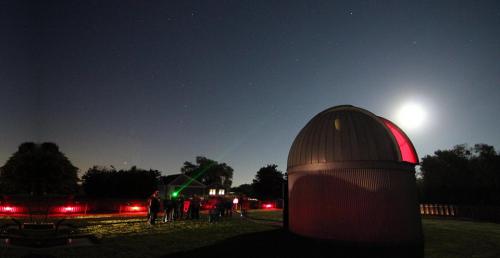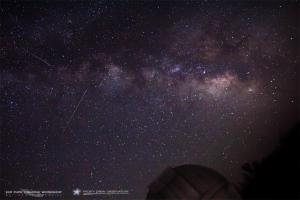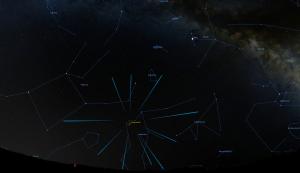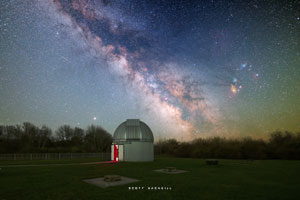Celebration of Space - April 30, 2021
Over the past several weeks, we have been experiencing a new occurrence during our Stargazing Nights event at Frosty Drew Observatory, and I think it is important to note that during the springtime at Frosty Drew we are operating in a down-season capacity. This is because we do not often have a large influx of visitors during the late winter, and springtime months. Due to the pandemic, we have to manage everyone who visits. As a result, our limit on the number of visitors we can admit into the Courtyard changes weekly depending on how many team members are on that night. The ticketing system we utilized in 2020 is not currently in use, and we are asking visitors to properly prepare for their visit by reading the materials we have published on our website regarding visiting during the pandemic.
Visiting the Observatory and Science Center: https://frostydrew.org/observatory/visiting.php
Frosty Drew’s evolving statement on the pandemic and how it affects our operations: https://frostydrew.org/2020-contagion.php
If our Courtyard limit is reached, visitors will have to wait to be admitted. This could result in visitors being turned away. We cannot service visitors until sunrise at this time, and have clearly posted 10:30 pm as our close time. Our dome will fit 30 visitors at a time comfortably, though pandemic related mandates will not allow that. As a result visitors have to wait. Complaining to us on a public forum or posting bad reviews about Frosty Drew because of this is counterproductive and will not solve the problem. We ask that visitors understand that we are doing our best at this time in regards to pandemic related limitations and that the majority of our team are volunteering their Friday nights to introduce visitors to the cosmos. For those that get this, we are truly grateful for your patience and understanding.
Now that meteor shower season is back in action, another notable meteor shower is occurring. During the morning hours on Wednesday, May 5, 2021, the annual Eta Aquariid Meteor Shower will peak. Bringing with it an increase in regular meteor activity by around 40 meteors per hour, the Eta Aquarrid shower is a good show to observe. But that rate is what you would see under fantastic viewing conditions. Which means no clouds, no Moon, and when the radiant point of the shower, where all meteors appear to originate from, is well above the horizon. This Wednesday, the 38% waning crescent Moon will rise at 2:15 am, which will somewhat impact viewing conditions, but will not be a showstopper.
The Eta Aquariid shower is a result of comet 1P / Halley (Halley’s Comet). As Halley’s Comet makes its 75 year orbit around the Sun, it leaves behind a trail of tiny comet particles. These particles are dust and rice grain sized pieces of ice and rock. When the comet starts to approach the Sun, its interaction with the solar wind heats up the comet’s nucleus, causing it to out-gas. This out-gassing will release a lot of loose particles on the comet, which causes a debris field to form along the orbit of the comet. As Earth orbits through the debris field, the tiny particles of comet are captured by Earth’s gravity and enter Earth’s atmosphere at rates of 42 miles per second. The mass of Earth’s atmosphere is too great for the speed so the tiny particles burn up, leaving streaks across the sky.
Viewing the Eta Aquariid meteor shower should be quite acceptable with the late Moon rise. Find a dark spot, largely free of artificial light, with a wide open view of the sky. Lay on your back with your feet to the NW and look upwards toward zenith (top of sky) to see meteors passing by. Meteors will appear to radiate from the star Eta Aquarius, which is where the shower gets its name from.
This is also a fantastic opportunity to catch a prime view of the bright Milky Way Galactic Nucleus. Springtime is the best time to catch this view, and early May places visibility of the Milky Way in the early morning hours. About 1 hour before the Moon rises on the 5th, the Milky Way will be strikingly visible over Frosty Drew Observatory. Creating a perfect backdrop for the occasional shooting star. So hope for clear sky conditions and set out for a night of shooting stars, the Milky Way, and a proper welcome of the cross quarter day the previous Saturday, May 1st.
Today, April 30, 2021, Earth will arrive at the point in its orbit where we are on the opposite side of the Sun than the planet Uranus. This is called Superior Conjunction, and occurs once per year. At noon today, Uranus was near its maximum distance from Earth, at 1,930,000,000 miles distant, for our year. After today, Uranus will start to move back into position for observation, which will kick in this summer during the morning hours.
Tomorrow, Saturday May 1, 2021 is one of the four cross-quarter days of the year. Known as May Day, tomorrow will mark our halfway point through spring in the Northern Hemisphere. Cross-quarter days are generally aligned with a religious holiday, or property rent due dates for those in England. For us, it’s a good indicator that we are starting the last approach to summer in the Northern Hemisphere. Other cross-quarter days are Groundhog Day (February 2nd), Lammas (August 1st), and Halloween (October 31st). So take a moment tomorrow to step outside, check out some flowers and leaf blooms, and welcome May Day in seasonal style. Have a Happy May Day from all the astrogeeks at Frosty Drew Observatory and Science Center.
- Author:
- Scott MacNeill
- Entry Date:
- Apr 30, 2021
- Published Under:
- Scott MacNeill's Columns






